It is the same story, but a different year when it comes to describing the Buffalo Sabres. The team has not qualified for the playoffs since the 2010-11 season, and they are poised to miss again. When this streak started, Jason Pominville was still months away from being named the 13th captain in franchise history. Ville Leino had yet to sign with the team after a 53-point season with the Philadelphia Flyers. This decade that has been full of disappointment and misery is the opposite of what happened in the preview 10-year span, which saw the Sabres make the Eastern Conference Final twice.
Going through what has gone wrong these past 11 years, the storylines that emerged as the seasons progressed, and how the team failed to improve over that span shows the legacy of failure that will haunt this franchise for the rest of its existence .
2011-12: Just Missing the Playoffs
This season can be known as the year the Sabres nearly made the postseason but just fell short. Pominville had scored 30 goals and 73 points in his first season wearing the captaincy, and third-year Tyler Ennis started to break through as a scoring threat for this team. Ryan Miller and Jonas Enroth each had a .916 and .917 save percentage, respectively, and gave this team a chance to win in every game. Despite that, Christian Ehrhoff as the best defenseman and Derek Roy as the first-line center factored into this disappointing season.
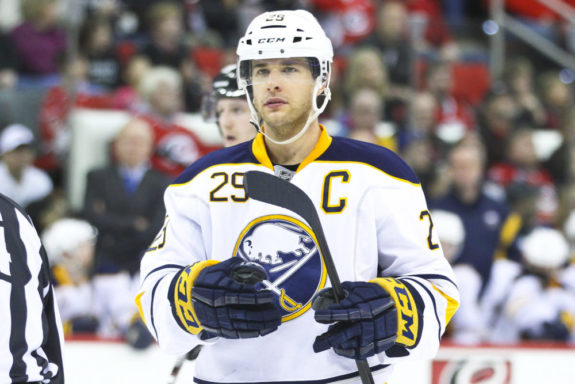
When looking at the trades made throughout this season, the biggest two were acquiring Cody Hodgson from the Vancouver Canucks for Zack Kassian, and trading Paul Gaustad for a first-round pick from the Nashville Predators (a pick that ultimately turned into Zemgus Girgensons). It was clear that the team was trying to get younger and stock up on draft capital as making the playoffs would not be a guarantee.
Overall, the team finished with a record of 39-32-11, and they just fell short of qualifying for the postseason. The Sabres had two first-round selections in the 2012 NHL Draft. With the 12th-overall selection, they picked Mikhail Grigorenko, who was traded to Colorado in the Ryan O’Reilly trade, and then subsequently left the NHL to play some successful seasons in the KHL (Kontinental Hockey League) before returning to play for the Columbus Blue Jackets. He would then go back to Russia after yet another disappointing NHL stint. At 14th overall, they selected Zemgus Girgensons, who is still on the team and played a key leadership role in 2022. Both were selected too high for the caliber of player that they became. Linus Ullmark was a steal at 163rd overall, but the Sabres couldn’t convince him to stick around in 2021.
2012-13: This Team Needs Direction
In the offseason, the Sabres traded away Roy to the Dallas Stars and acquired Steve Ott and Adam Pardy (from ‘Sabres trade Derek Roy to Stars for Steve Ott, Adam Pardy,’ National Post – 07/02/2012). That trade didn’t produce much for either team unfortunately. This was a shortened lockout season, which saw each team play only 48 games. It was clear that the team was heading towards a rebuild, but they weren’t bad enough to be the league’s worst team just yet.
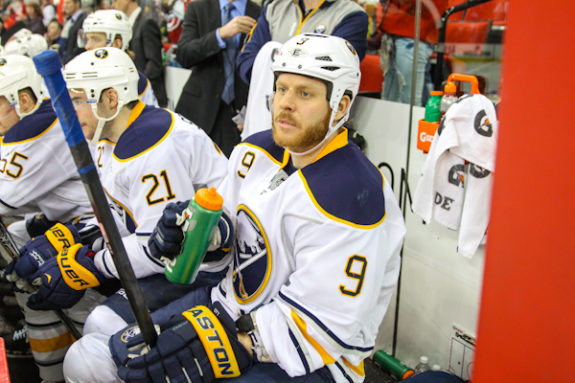
Over the course of the year, the Sabres acquired seven draft picks to see the team part ways with numerous players. The most notable was Pominville, as he was traded to Minnesota along with a 2014 fourth-round pick, in return for Matt Hacket, Johan Larsson, a 2013 first-round pick, and a 2014 second-round pick from the Wild. In hindsight, that was a solid trade for the Sabres, as Pominville would decline over the next several seasons.
Related: Buffalo Sabres Report Card Through First Half of Season
The team finished the season with a record of 21-21-6 and clearly missed the playoffs this time. They had the eighth-overall selection in the 2013 NHL Draft and used it to select Rasmus Ristolainen. He was a controversial player among the fanbase during his tenure as a Sabre, but he did the best with what he was given.
2013-14: The First Tank Season and the End of the Miller Era
The tank had officially started, and all eyes were on the prospects available for the coming draft. Aaron Ekblad was the favorite, but players such as Sam Reinhart, Sam Bennett, and Leon Draisaitl would possibly overthrow him. Cody Hodgson, who had not played in the NHL since 2016, led the team in scoring with 20 goals and 44 points. Their goaltending was the only reason why they didn’t lose in every single matchup.
To have the best possible chance at acquiring any of those players, the team had to part ways with several key members on the roster. Ryan Miller and Steve Ott were sent to the St. Louis Blues for Jaroslav Halak, Chris Stewart, William Carrier and two draft picks that the Sabres ultimately traded again. Thomas Vanek was traded for a declining Matt Moulson and a first round pick they subsequently traded to the Senators and a second round pick (Brendan Guhle). After gutting the core of that team, they finished with a record of 21-51-10 after 82 games.
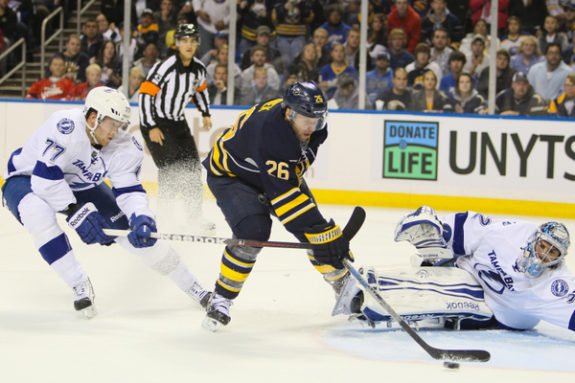
The team lost the draft lottery and ended up with the second-overall selection in the 2014 NHL Draft and used it to select Sam Reinhart. He became one of the most consistent scorers for the Sabres as he developed into a key two-way winger with a distinct scoring touch over the next few seasons. Victor Olofsson was chosen in the seventh round and has provided amazing value for his draft positioning as he’s become a threat to score plenty of goals for years to come.
2014-15: Getting McDavid at All Costs
If there was ever a season to tank, it was this one. Everybody in the hockey world knew who the first-overall pick would be, and that was superstar forward Connor McDavid. The team was clearly awful, as they had been trading roster players for draft capital over the last couple of seasons. It was quite clear what they were doing. This was the season that Michal Neuvirth started 27 games, played well in his starts, and had to be traded to avoid sabotaging the tank.
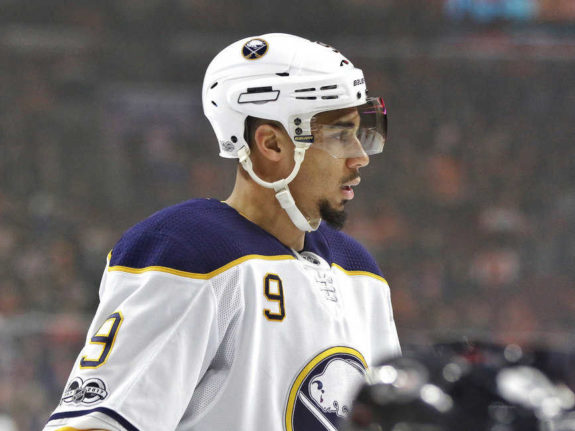
The Sabres doubled down on the tank effort while building for the future by acquiring polarizing forward Evander Kane, Zach Bogosian, and Jason Kardorf from the Winnipeg Jets in exchange for Brendan Lemieux, Joel Armia, Drew Stafford, Tyler Myers, and a 2015 first-round pick (via St. Louis). This was a blockbuster trade at the time, as Lemieux was seen as one of the team’s best prospects, and Myers was a part of their top two defensive pairings. Kane would be a scoring threat during his time in Buffalo, and it was a deal that benefitted both teams at the time. By season’s end, the team finished with a record of 23-51-8.
Related: Sabres GM Kevyn Adams Predicts More Change After Krueger Firing
On April 15, 2015 the draft lottery came. This was the day that Sabres fans were looking forward to the most; the chance to pick first overall and select the best player to come into the league since Sidney Crosby. The results came in, and the NHL’s Deputy Commissioner Bill Daly flipped over the golden card, and the first-overall selection ended up going to the Edmonton Oilers. The Sabres got their consolation prize in Jack Eichel at second overall, but the disappointment on GM Tim Murray’s face was very apparent. Since then, McDavid has become arguably the best player in the league as he continues to collect 100-plus point seasons.
2015-16: There Is Hope in Buffalo
Finally, there was some excitement surrounding the organization. It was four years since the team last made the postseason, and their chances grew when they inserted Eichel into the lineup. Eichel would put up 24 goals and 56 points in his rookie season, Kane would score 20 goals, and Reinhart continued to grow with a 42-point season. To add on to the skill pool of the roster, GM Tim Murray would make a pair of trades to fill the remainder of the Sabres biggest needs; goaltending and leadership.
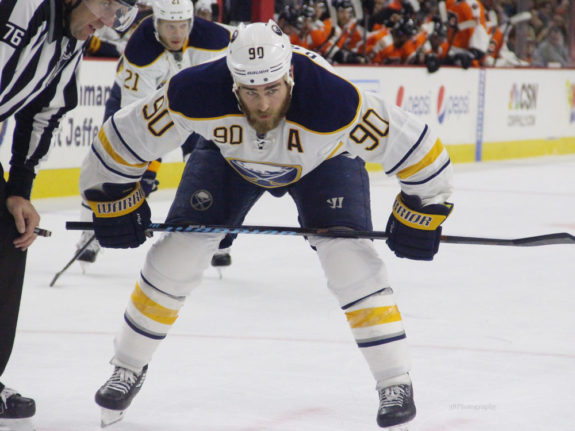
The Sabres acquired Ryan O’Reilly during the 2015 draft along with Jamie McGinn from the Colorado Avalanche. They sent back Nikita Zadorov, Mikhail Grigorenko, J.T. Compher, and a 2015 second-round pick. O’Reilly wanted more than the Avalanche were going to pay for his services, but the Sabres were more than willing to by handing him a contract worth a total of $52.5-million over seven years ($7.5-million AAV). O’Reilly proceeded to put up 60 points in 71 games during this season, leading as the team’s first-line center to allow for Jack Eichel’s development.
The Sabres also made a trade with the Ottawa Senators that would bring in a young Robin Lehner to become their starting goaltender. Lehner would become plagued with illness and injury problems during the course of his Sabres career sadly.
Related: Buffalo Sabres Report Card Through First Half of Season
The team finished with a record of 35-36-11, accumulating 27 more points than the previous season. During the 2016 NHL Draft that was held in Buffalo, the Sabres selected Alex Nylander with their eighth-overall pick. From this draft, the Sabres lost on a few of their picks, but players like Rasmus Asplund, Brett Murray, and Casey Fitzgerald still remain with the team in 2022. Of the other notable players chosen by the Sabres that year, Alex Nylander hasn’t made himself an NHL regular yet, and Brandon Hagel was sent to the Lightning by the Blackhawks for a massive draft pick haul. Former GM Jason Botteril never even offered Hagel an entry level contract…
2016-17: Some Assembly Required
This was a season that plagued the team with a key injury as Eichel missed the first seven weeks after suffering a high-ankle sprain in practice. This was also Kyle Okposo’s first season as a Sabre, and he put up a respectable 45 points in 65 games. Although the playoffs were in reach during multiple points of this particular season, they fell short once again.
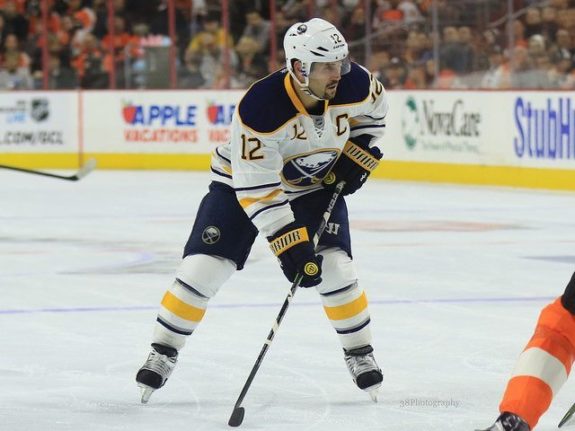
Leading up to the season, the Sabres had acquired Jimmy Vesey for a 2016 third-round pick from the Nashville Predators, as he was the biggest college free agent on the market. Ultimately, Buffalo couldn’t convince him to sign with the team, and he left for the New York Rangers. The only trade deadline acquisition for the team was Mat Bodie, and they moved Daniel Catenacci to the Rangers. The team would end up finishing with a record of 33-37-12, missing the playoffs by 17 points.
At the 2017 NHL Draft, the team had the eighth-overall selection for the second year in a row. With that pick, they selected Casey Mittelstadt, who has some physical issues hurt his draft stock a bit. He had very high expectations, and with his emergence in 2021 under current coach Don Granato, he may finally be reaching his potential. Ukko-Pekka Luukkonen is still developing but is the current frontrunner for the Sabre’s 2022 goaltending position. Oskari Laaksonen is developing still in Rochester. Jacob Bryson was selected in the fourth round of that draft and has been a mainstay of the Sabres blue line for 2021 and 2022. Linus Wiessbach was the Sabres last selection of that draft year and currently plays for the Americans as well. The final results from this draft class are still being determined.
2017-18: Fallin for Dahlin
The Sabres should have had a team for Eichel at this point, but they actually got worse. In the offseason, they re-acquired Pominville, as well as adding Marco Scandella and Nathan Beaulieu. This ended up being O’Reilly’s last season with the team, despite putting up another 60-point season. He lost his love of the game, stating, “That’s how I kind of fell out of love with it, and I miss that. I want to get back to myself.” (Sabres’ Ryan O’Reilly says he lost the love of the game, lacked mental toughness,” The Buffalo News – 04/09/2018). O’Reilly was sent to the St. Louis Blues in exchange for Vladimir Sobotka, Tage Thompson, Patrik Berglund, a 2019 first round pick (Ryan Johnson), and a 2021 second round pick.
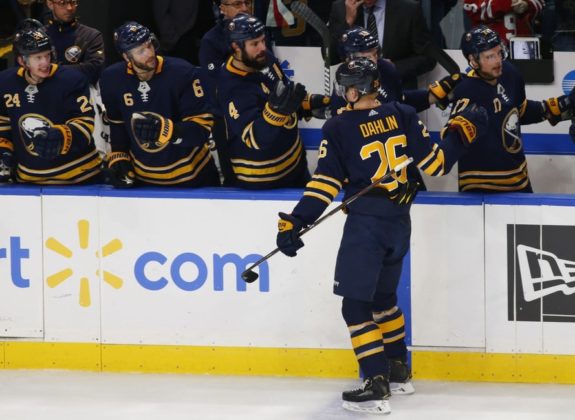
At the trade deadline, Kane was sent to the San Jose Sharks for a 2019 first-round pick, Daniel O’Regan, and a 2020 fourth-round pick. He was scoring at a 30-goal pace, but the team was clearly going to be one of the last-place teams, and they wanted the best chance to draft Swedish defenseman Rasmus Dahlin. That would end up being the case, as the Sabres finished with a record of 25-45-12, which put them dead last in the NHL once again.
After such a terrible season full of setbacks and heartaches, there was somehow still some hope within the organization. The Sabres won the draft lottery and selected Dahlin with the first-overall pick in the 2018 NHL Draft. Dahlin has blossomed into the Sabres’ top defenseman and will only continue to improve.
2018-19: This Team Is Unstoppable, Except They’re Not
The Sabres looked poised to make the postseason for the first time in eight seasons, as they went on a 10-game winning streak in November, making their record after 25 games an outstanding 17-6-2. (“Sabres ride longest winning streak of season into grueling stretch”, The Buffalo News – 11/15/2018). The key factor on why the team was outperforming expectations was Jeff Skinner, who the Sabres acquired from the Carolina Hurricanes in change for Cliff Pu, a 2019 second-round pick, and a 2020 third- and sixth-round pick. How could a season full of so many positives end up derailing so quickly?
The team went 16-33-8 in the remaining 57 games of the season, and once again, there were no depth scoring players. Jack Eichel, Sam Reinhart, and Jeff Skinner were forced to carry the brunt of the offense every night, which was not a recipe for sustained success. In the previous offseason, Robin Lehner left the team, and it hurt them at the goaltending position. He put up around a .920 save percentage when he was in Buffalo, and they couldn’t replace it. They signed Carter Hutton to a three-year contract, worth an average annual value of $2.75 million — he underperformed immediately and never got back to the form he was showing in Nashville and St. Louis.
After everything went right, the true Sabres had awoken and that led to another season full of failures.
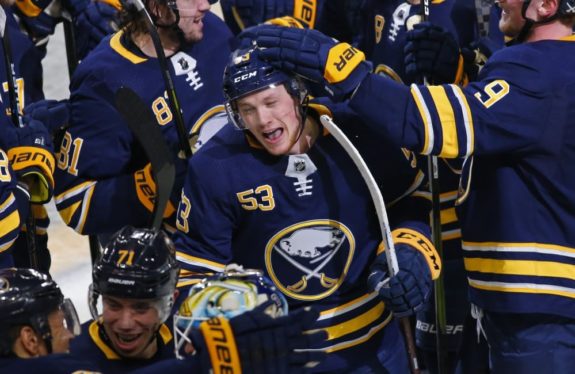
At the trade deadline, the team believed that they could still fight for a wildcard spot and acquired Brandon Montour from the Anaheim Ducks. In that deal, they sent prospect Brandon Guhle and a 2019 first-round pick (via San Jose), which sent the message that losing was no longer acceptable. In the end, the team finished with a record of 33-39-10, missing the playoffs by 22 points.
Related: Sabres GM Kevyn Adams Predicts More Change After Krueger Firing
At the 2019 NHL Draft, the team had two first-round picks, as they acquired one in the O’Reilly trade. First, with the eighth-overall selection, they picked Dylan Cozens from the Western Hockey League. He recently had a very quietly productive season in his sophomore year and looks to be a solid top-six option for years to come since he has the ability to play both center and wing. Ryan Johnson was selected with the 31st pick and is still yet to sign with the Sabres out of college.
2019-20: Is This Finally the Year?
In the offseason leading up to the 2019-20 NHL season, the Sabres made deals to make their team better. They re-acquired Vesey and snagged Colin Miller for the blue line. They traded a struggling Alex Nylander for Henri Jokiharju; a trade that worked out miles better for the Buffalo Sabres as Jokiharju has been a staple partner for Dahlin and one of their best defensive players overall. Although the on-paper roster looked promising, the Sabres could not make the postseason for the ninth year in a row. This was when the Eichel trade rumors started to gain traction.
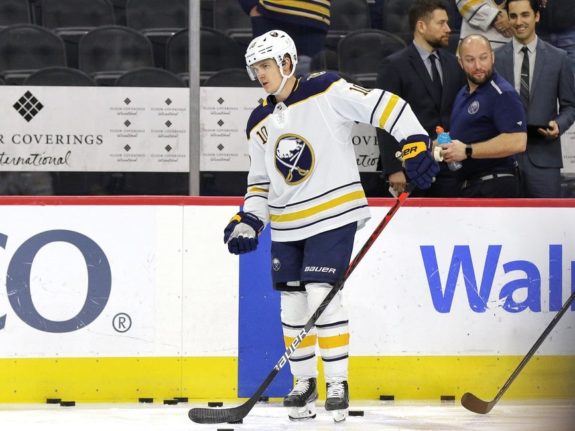
The trade deadline saw the team get bamboozled by the Canadiens, as they sent Scandella to Montreal for a 2020 fourth-round pick, and the Habs flipped him a month later to St. Louis for a 2020 second- and fourth-round pick. The Sabres acquired Wayne Simmonds from the New Jersey Devils for a 2021 conditional fifth-round pick at the trade deadline as a meager showing of a “push to win”. The biggest move was acquiring Dominik Kahun from the Pittsburgh Penguins for Conor Sheary and Evan Rodrigues, which was seen as a terrific deal at the time. Kahun was an upgrade over Sheary, and Rodrigues was bad in his role on the team’s bottom-six forward lines. Since then, Kahun has fizzled out of the league and Rodrigues has found new life as a top-six player for the Penguins.
Related: NHL Rumors: Oilers, Stars, Senators, Sabres and Hall, More
The 2020 NHL Draft saw the team have the eighth-overall selection for the fourth time in five seasons, and with that pick, they selected Jack Quinn. Due to the pandemic, he got the chance to be on the Sabres’ taxi squad and play with the Rochester Americans in the AHL. Although there were players in Marco Rossi and Cole Perfetti who were seen as better options, Quinn has emerged as one of the Sabres top two prospects beside fellow 2020 draft pick JJ Peterka.
2020-21: Ralph Krueger and Taylor Hall Experiments Fail Miserably
Free agency in 2021 was a bit strange as Taylor Hall was the “big fish” to be caught. Everyone in the league, fans and analysts alike assumed that he would be snatched up by a playoff team. They were all wrong and shocked when the announcement came that Taylor Hall would be signing a one year $8-Million contract with the Buffalo Sabres. Eichel would have another superstar caliber player to help him carry the team, and things seemed to be on the up trend.
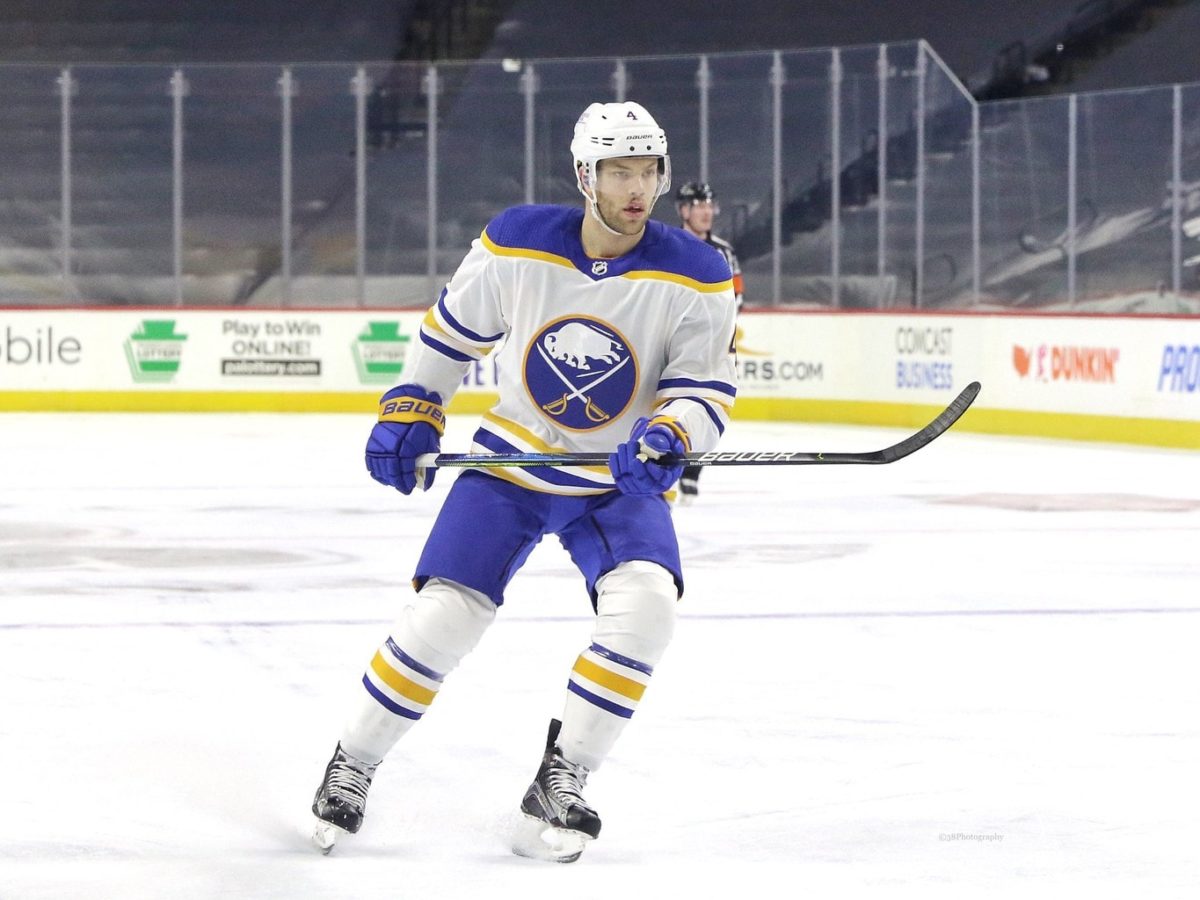
Fast forward half a year and the Sabres are without Eichel who had an undisclosed injury at the time (later to revealed as his neck injury) and they were riding a record setting losing streak. Now former head coach Ralph Krueger had lost all confidence from his players, from management, and most of all the fans. Fan had been calling for his job for weeks before his eventual termination. What followed was the hiring of Don Granato to lead the team out of their massive slump. While it took a few games for them to get things together, Granato had them playing like an entirely different team.
The trade deadline that season saw the Sabres move on from Taylor Hall who had only amassed two goals and 19 points in 37 games. He was traded to the Boston Bruins along with Curtis Lazar for Anders Bjork and a second round pick in 2021 (Alexander Kisakov). One thing was still left to deal with by the time the season ended, and that was the state of Jack Eichel. Was his time as a Sabre coming to an end? What was his injury that kept him out all season?
Related – Jack Eichel’s Best Moments As a Buffalo Sabre
Locker room clean out day came and Eichel was finally made available to the media. In his exit interview he made it clear that there was a “disconnect” between himself and management on how to handle his neck injury. This truth spawned one of the most dramatic standoffs in league history as Eichel made it clear that he was unhappy.
The Sabres finished last in the league with an abysmal 15-34-7 record and earned the right to pick first overall once again at the draft.
2021-22 The Eichel Era Ends In Flames
At the 2021 NHL draft, the Sabres were in full firesale mode. They were ready to tear it down to their base prospects and move out the core players who hadn’t accomplished what was originally anticipated in 2013-14. Sam Reinhart was traded to the Florida Panthers for a 2022 first-round pick and top goalie prospect Devon Levi, a price that felt low considering how well Reinhart had played in every situation for Buffalo. Rasmus Ristolainen was moved to the Flyers in exchange for the 14th-overall pick in 2021 (Isak Rosen), a 2022 second-round pick, and Robert Hagg. This move was seen as a steal for Buffalo considering how polarizing Ristolainen was.
Jack Eichel was still stuck for a while longer, but the Sabres made a big selection with their first-overall pick. They chose the towering defenseman from Michigan named Owen Power, and the future of the Sabres’ blue line got much brighter that day. Drawing comparisons to All-Star defender Victor Hedman, Power had all the right qualities of a top-end defenseman. The Sabres were in no rush to bring him to the NHL as GM Kevyn Adams knew his team would struggle with a depleted roster. Power elected to return to Michigan for another season, and ultimately ended up losing out on the national championship for a second time.
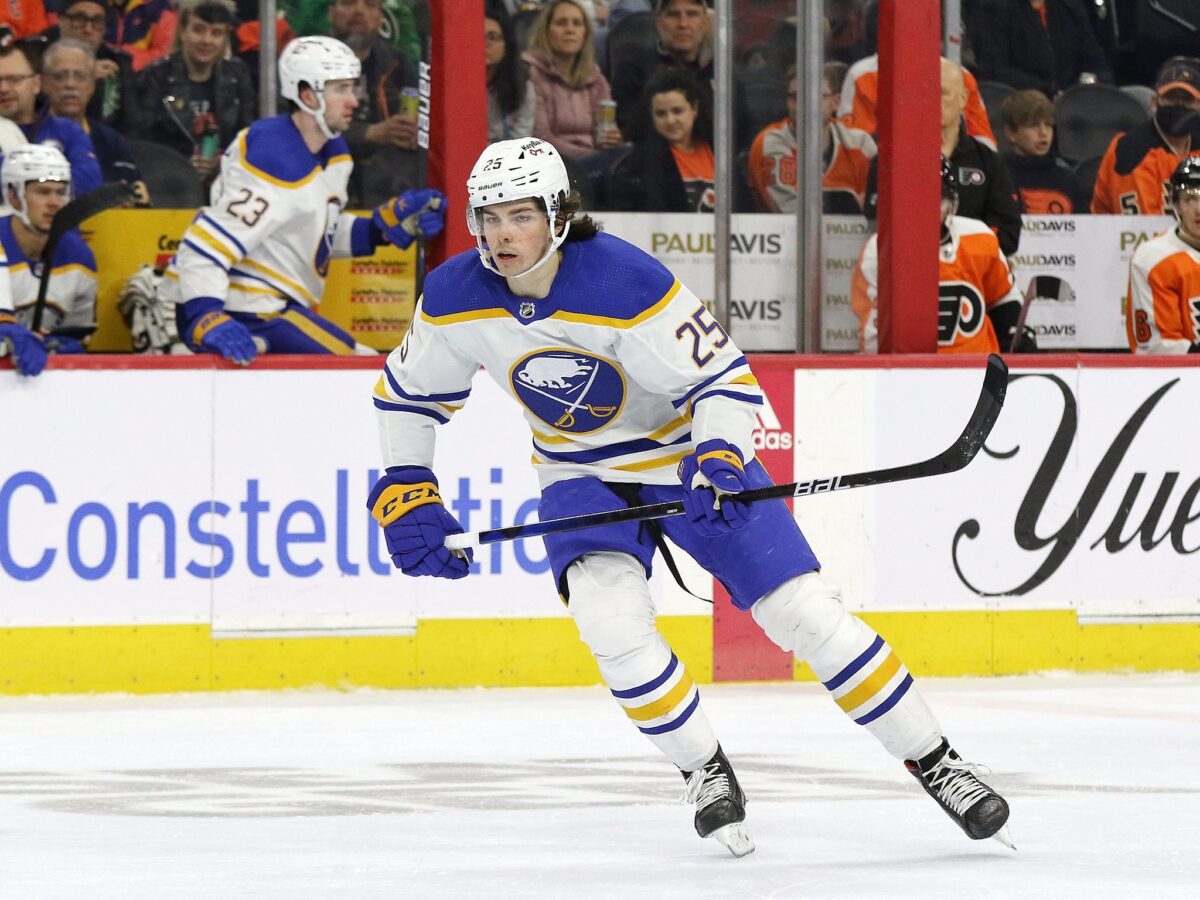
The season started and Jack Eichel was still a Buffalo Sabre. He had been stripped of the captaincy and failed his initial physical so he was unable to join the team. Rumors of his toxicity spread more and more prior to his trade on Nov. 4, 2021, but after a long dramatic standoff between him, the Sabres, and his agent, Eichel was traded to the Vegas Golden Knights along with a 2023 third-round pick for Alex Tuch, Peyton Krebs, a 2022 first-round pick, and a 2023 second-round pick.
Tuch still had to recover from the surgery that he had, but once he joined the team for some gameplay, he almost instantly became a fan favorite. He played a tough physical game and he went to work on every shift. He found a home next to Tage Thompson and Jeff Skinner who both put up insane breakout numbers. Skinner got out of his massive scoring slump and finished with 33 goals and 30 assists, while Thompson amassed an incredible 38 goals and 30 assists.
Related – Sabres Top 5 Candidates for Their Next Captain
The Sabres had shed the shroud of negativity that surrounded Jack Eichel and emerged as a hard-working team that could actually compete on a nightly basis with some very good teams. Don Granato brought the best out of every one of his players and wasn’t afraid to make them work for everything. He elevated so many young players from average to excellent in his first full season as coach, and it only leaves hope for so much more as the Sabres look forward to next season.
The Sabres finished with a record of 32-39-11. Could they break the streak of playoff misses in 2022-23? If top prospects like Jack Quinn and JJ Peterka can produce as they do in the minors, then yes… Absolutely.
